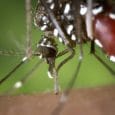Battling Chicken Mites with Bags of Brimstone July 18, 2016 by Entomology Today Leave a Comment 
A northern fowl mite (Ornithonyssus sylviarum). Photo by Blaine Mathison.
By Meredith Swett Walker
The northern fowl mite (Ornithonyssus sylviarum) plagues chickens, causing inflammation, anemia, and basically making them itch like the devil. The mites are the most common ectoparasite found on poultry. But researchers from the University of California, Riverside have come up with a diabolically clever way to control the little bloodsuckers — bags of brimstone.

Meredith Swett Walker
Brimstone is a Biblical term for the element sulfur, which has long been used as an organic pesticide. In the latest issue of the Journal of Economic Entomology, researchers Amy Murillo and Bradley Mullens evaluate a novel technique for using sulfur to control northern fowl mites on chickens. By providing sulfur in a “dust bag” and allowing chickens to “treat themselves” with the pesticide, Murillo and Mullens have devised a low-tech treatment for a modern poultry problem.
Northern fowl mites are an economically important pest. Infestations can lead to a 10-15% reduction in egg production and reduced weight gain as well. Most large commercial poultry production facilities house their chickens in wire battery cages — simple wire boxes with wire floors. In these types of facilities, ectoparasites are controlled by using high-pressure insecticidal sprays that can penetrate the cages and the chicken’s feathers to contact mites, lice, and fleas. But as many poultry producers transition away from battery cages due to animal welfare concerns, parasite control becomes problematic. When chickens are kept in enriched cages with perches and nest boxes, or even cage-free, the structure of these cages (or lack thereof) makes it difficult for insecticidal sprays to access all parts of the chicken. In addition, parasites appear to be developing resistance to many of the common insecticides.
Sulfur dust has been used for decades to control mites on chickens. The sulfur is usually provided to chickens in a “dust bath,” essentially a box of dust, which may contain fine dirt, sand, diatomaceous earth, insecticides and other powdery substances. The chicken sits in the dust and fluffs it into its feathers to remove parasites — this is a natural chicken behavior. Sulfur dust baths are very effective at controlling northern fowl mites, even for chickens in the same coop that do not use the dust bath. But dust baths may not be practical in larger commercial poultry houses where numerous chickens dust bathing might cause a large amount of sulfur to be kicked up into the air.

The white gauze bag hanging in this chicken’s cage contains sulfur dust. Photo by Amy Murillo.
“Self-treatment” with insecticidal dust bags has been used in cattle husbandry for decades, but, until now, the method had not been attempted with poultry. Murillo and Mullens strategically positioned small gauze bags of sulfur dust in the chickens’ cages where the chickens were likely to brush up against them, such as near a food dish. The chickens effectively dusted themselves with sulfur when they fed.
The researchers compared the effectiveness of sulfur bags hung from the top of the cage to bags clipped to the floor of the cage. They also included a permethrin strip treatment to compare sulfur to a more conventional pesticide. Permethrin strips are sold commercially to control northern fowl mites. The product consists of a plastic strip impregnated with permethrin pesticide that is hung from the top of the chicken’s cage. As with the sulfur dust bag, when the bird brushes up against the strip, the pesticide is applied to its feathers.
Sulfur dust bags proved more effective than the permethrin strips. On average, sulfur reduced mite infestations to low levels within one week of treatment and eliminated mites as of three weeks post treatment. Hanging dust bags worked better than bags affixed to the cage floor and the authors believe that the chickens contacted the hanging bags more frequently. Treatment with permethrin strips had no significant effect on mite infestations despite the chickens making frequent contact with the strips. Further testing revealed that the mite population used in this experiment was resistant to permethrin. Murillo suspects that permethrin resistance may be widespread among northern fowl mites in commercial poultry facilities.
With the dust bag technique, the chickens apply the sulfur treatment themselves, much as they do with a dust bath. While they might not apply it intentionally, “self-treatment” significantly reduces stress on the bird. It also reduces labor for poultry workers and cuts down worker exposure to sulfur dust. Imagine attempting to manually apply dust to an irate chicken and the advantages of a dust bag are obvious. In addition, the targeted approach of the dust bag would reduce the amount of sulfur dust floating in the air should this technique be used in a large commercial poultry house. While sulfur is only slightly toxic for humans, there is a risk that it may ignite if the dust is densely suspended in the air. (Fun fact: elemental sulfur is one of the fuel components of gunpowder.)
The sulfur dust bag technique has potential for use by both commercial producers and backyard chicken keepers.
“I think the dust bags could be adapted to almost any type of housing, including backyard chickens,” said Murillo. “Every situation with chickens is a little different, but most will have nest boxes and all will have food and water. Dust bags could be hung near these resources for birds to come in contact with occasionally.”
Despite the fact that sulfur has long been used to control mites, the physiological mechanism by which it kills the pests is unknown. It is thought that some of the sulfur dust is converted into hydrogen sulfide by the chicken’s body heat and that this compound works as a fumigant. Hydrogen sulfide is best known for its “rotten egg” smell. Murillo admits that the chickens in the sulfur treatment group were a little bit stinky, but she expects that the odor would be reduced in real-world situations where fewer dust bags would be used.
Still, a slight foul odor seems a small price to pay for fowl mite control. With sulfur dust bags, Murillo and Mullens have used an old-fashioned remedy and applied it in new way, resulting in happier, healthier, itch-free chickens.
Read more at:
– Sulfur Dust Bag: A Novel Technique for Ectoparasite Control in Poultry Systems
Meredith Swett Walker is a former avian endocrinologist who now studies the development and behavior of two juvenile humans in the high desert of western Colorado. When she is not handling her research subjects, she writes about science and nature. You can read her work on her blogs https://picahudsonia.com and https://citizenbiologist.com or follow her on Twitter at @mswettwalker.



